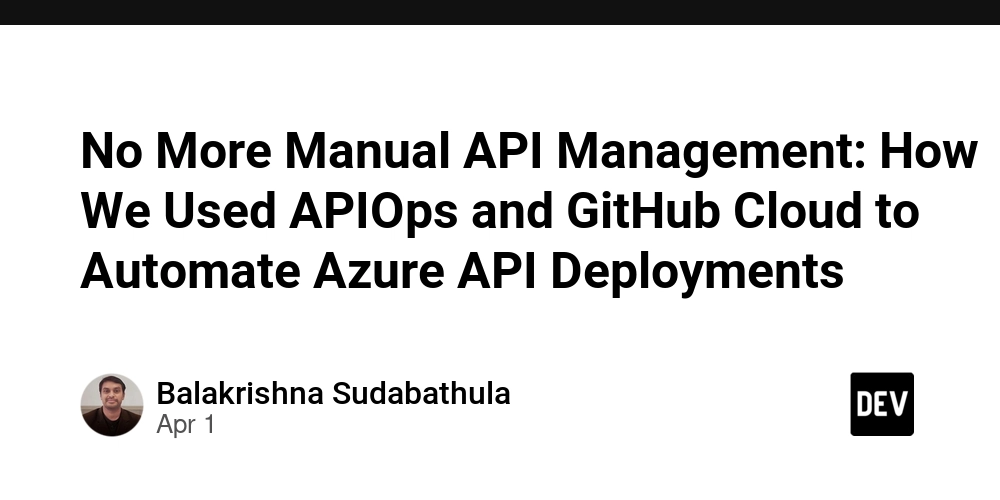No More Manual API Management: How We Used APIOps and GitHub Cloud to Automate Azure API Deployments
The Problem We Faced In modern enterprise environments, APIs are the nervous system that powers digital experiences—from internal microservices to customer-facing applications. At our organization, developers were manually publishing APIs directly into Azure API Management (APIM) through the portal. While this approach offered flexibility, it quickly became a bottleneck: Configuration drift across environments Inconsistent application of policies Lack of audit trails Security vulnerabilities due to human error To address these issues, we implemented a modern approach: APIOps, paired with GitHub Cloud. This powerful combination enabled us to treat APIs as code, automate the deployment lifecycle, and ensure consistency across environments. What Is APIOps? APIOps is the application of DevOps principles to API development and operations. It integrates version control, continuous integration and delivery (CI/CD), automated policy enforcement, and observability into the API lifecycle. With APIOps, every change—whether to an OpenAPI definition or an inbound policy—is made via Git, reviewed via pull requests, and deployed automatically using CI/CD pipelines. Benefits of APIOps include: Version-controlled API definitions Peer-reviewed configuration changes Automated deployments Consistent application of security policies Elimination of manual portal access Why GitHub Cloud and Azure API Management We standardized on GitHub Cloud for code hosting and automation, and continued leveraging Azure APIM as our API gateway. Using GitHub Actions, we were able to create event-driven workflows that could deploy APIs, policies, and metadata without user intervention. While tools like Terraform and Bicep are well-suited for infrastructure provisioning, Microsoft’s APIOps framework gave us a purpose-built structure for managing API definitions and policies without the need for additional IaC tooling. Implementation Overview Repository Structure Our GitHub repository followed the APIOps-recommended layout, enhanced with environment-specific folders: /apis /customer-api /dev /definitions - api-definition.yaml /policies - inbound.xml - outbound.xml /metadata.json /qa /definitions - api-definition.yaml /policies - inbound.xml - outbound.xml /metadata.json /prod /definitions - api-definition.yaml /policies - inbound.xml - outbound.xml /metadata.json This modular, environment-specific structure allowed development teams to manage APIs independently per environment, while maintaining full control and consistency across Dev, QA, and Prod. GitHub Actions Workflow Our CI/CD pipeline included three main stages: OpenAPI Validation: Using Spectral and Swagger CLI to enforce consistency and quality. Policy Linting: Ensuring all XML policies were syntactically correct and followed our security guidelines. APIM Deployment: Using Azure CLI and the APIOps toolkit to publish changes. All deployments were tied to pull requests, ensuring traceability and approval gates. Policy-as-Code Examples Policies were modular and stored in Git as XML fragments. Inbound Policy: JWT Auth + Rate Limiting api-client-id Outbound Policy: Header Injection My API Platform Redis-Backed Caching for High-Performance APIs Some APIs experienced high read traffic. To reduce backend load, we integrated Azure APIM's external caching with Redis. Caching policies were defined as reusable fragments. Caching Policy: Some of our APIs experienced high read traffic due to frequent, repeated access to non-sensitive data. To reduce backend latency and offload repetitive requests, we implemented Azure APIM's external caching feature backed by Redis. Redis, as a high-performance in-memory data store, was ideal for storing response content with very low access latency. By combining Redis with APIM's caching policies, we could cache full API responses on the edge and avoid hitting the backend unless needed. We used metadata.json to define when caching should be enabled (e.g., for GET endpoints only). The GitHub Actions pipeline injected the cache policy conditionally based on those flags. This approach improved response time by over 40% for high-traffic endpoints and significantly reduced backend processing costs. Redis also gave us flexibility in cache expiration tuning and scaling horizontally. Business Benefits Improved Security Portal access was revoked All changes are traceable in Git Faster Onboarding Developers onboard APIs via pull requests No manual ticketing required Environment Consistency Identical policies and configurations across Dev, QA, and Prod Stronger Compliance JWT auth, CORS, caching, and throttling applied uniformly Operational Efficien

The Problem We Faced
In modern enterprise environments, APIs are the nervous system that powers digital experiences—from internal microservices to customer-facing applications. At our organization, developers were manually publishing APIs directly into Azure API Management (APIM) through the portal. While this approach offered flexibility, it quickly became a bottleneck:
Configuration drift across environments
Inconsistent application of policies
Lack of audit trails
Security vulnerabilities due to human error
To address these issues, we implemented a modern approach: APIOps, paired with GitHub Cloud. This powerful combination enabled us to treat APIs as code, automate the deployment lifecycle, and ensure consistency across environments.
What Is APIOps?
APIOps is the application of DevOps principles to API development and operations. It integrates version control, continuous integration and delivery (CI/CD), automated policy enforcement, and observability into the API lifecycle. With APIOps, every change—whether to an OpenAPI definition or an inbound policy—is made via Git, reviewed via pull requests, and deployed automatically using CI/CD pipelines.
Benefits of APIOps include:
- Version-controlled API definitions
- Peer-reviewed configuration changes
- Automated deployments
- Consistent application of security policies
- Elimination of manual portal access
Why GitHub Cloud and Azure API Management
We standardized on GitHub Cloud for code hosting and automation, and continued leveraging Azure APIM as our API gateway. Using GitHub Actions, we were able to create event-driven workflows that could deploy APIs, policies, and metadata without user intervention.
While tools like Terraform and Bicep are well-suited for infrastructure provisioning, Microsoft’s APIOps framework gave us a purpose-built structure for managing API definitions and policies without the need for additional IaC tooling.
Implementation Overview
Repository Structure
Our GitHub repository followed the APIOps-recommended layout, enhanced with environment-specific folders:
/apis
/customer-api
/dev
/definitions
- api-definition.yaml
/policies
- inbound.xml
- outbound.xml
/metadata.json
/qa
/definitions
- api-definition.yaml
/policies
- inbound.xml
- outbound.xml
/metadata.json
/prod
/definitions
- api-definition.yaml
/policies
- inbound.xml
- outbound.xml
/metadata.json
This modular, environment-specific structure allowed development teams to manage APIs independently per environment, while maintaining full control and consistency across Dev, QA, and Prod.
GitHub Actions Workflow
Our CI/CD pipeline included three main stages:
- OpenAPI Validation: Using Spectral and Swagger CLI to enforce consistency and quality.
- Policy Linting: Ensuring all XML policies were syntactically correct and followed our security guidelines.
- APIM Deployment: Using Azure CLI and the APIOps toolkit to publish changes.
All deployments were tied to pull requests, ensuring traceability and approval gates.
Policy-as-Code Examples
Policies were modular and stored in Git as XML fragments.
Inbound Policy: JWT Auth + Rate Limiting
api-client-id
Outbound Policy: Header Injection
My API Platform
Redis-Backed Caching for High-Performance APIs
Some APIs experienced high read traffic. To reduce backend load, we integrated Azure APIM's external caching with Redis. Caching policies were defined as reusable fragments.
Caching Policy:
Some of our APIs experienced high read traffic due to frequent, repeated access to non-sensitive data. To reduce backend latency and offload repetitive requests, we implemented Azure APIM's external caching feature backed by Redis.
Redis, as a high-performance in-memory data store, was ideal for storing response content with very low access latency. By combining Redis with APIM's caching policies, we could cache full API responses on the edge and avoid hitting the backend unless needed.
We used metadata.json to define when caching should be enabled (e.g., for GET endpoints only). The GitHub Actions pipeline injected the cache policy conditionally based on those flags.
This approach improved response time by over 40% for high-traffic endpoints and significantly reduced backend processing costs. Redis also gave us flexibility in cache expiration tuning and scaling horizontally.
Business Benefits
- Improved Security
- Portal access was revoked
All changes are traceable in Git
Faster Onboarding
Developers onboard APIs via pull requests
No manual ticketing required
Environment Consistency
Identical policies and configurations across Dev, QA, and Prod
Stronger Compliance
JWT auth, CORS, caching, and throttling applied uniformly
Operational Efficiency
Deployment time reduced from minutes to secs
Platform team focused on enablement, not firefighting
Final Thoughts
APIOps, powered by GitHub Cloud, allowed us to transform how we manage APIs across our enterprise. By shifting left and embracing policy-as-code, we eliminated manual overhead, improved compliance, and empowered development teams to deliver securely at speed.










![From drop-out to software architect with Jason Lengstorf [Podcast #167]](https://cdn.hashnode.com/res/hashnode/image/upload/v1743796461357/f3d19cd7-e6f5-4d7c-8bfc-eb974bc8da68.png?#)






























































